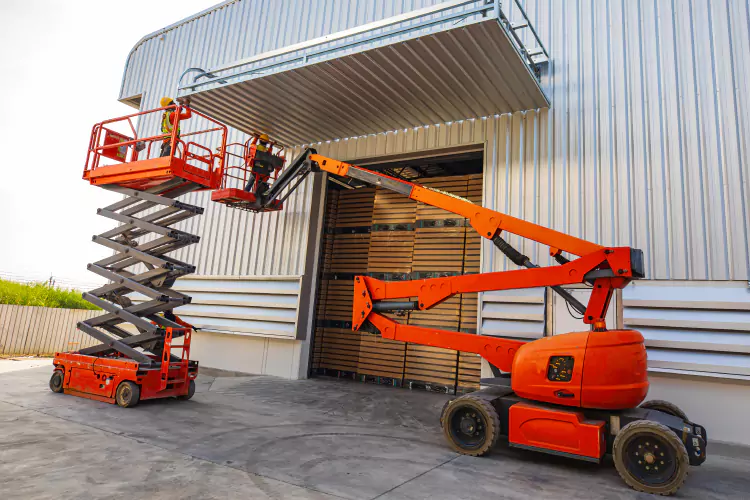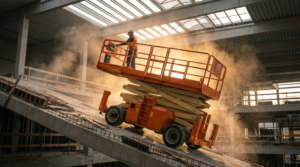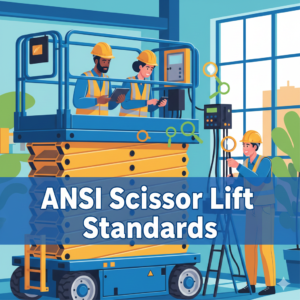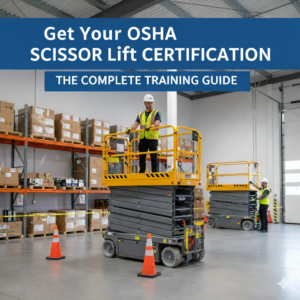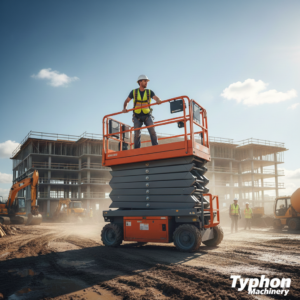Reaching new heights on the job sometimes requires going up in the air. While ladders and scaffolding are ever-present at worksites, they aren’t always the most stable or safest choice. This is where scissor lifts can help. Scissor lifts are elevating work platforms that utilize crisscrossed supports to smoothly raise employees to overhead work areas.
With proper precautions and training, scissor lifts provide an efficient and safe means of accessing height. However, misuse can lead to serious accidents. This article will explore scissor lift basics, pre-operation inspections, safe operating procedures, and situational awareness when working on and around these lifts. Following the guidance here will help ensure your jobs off the ground are accomplished safely.
Scissor Lift Fundamentals
Scissor lifts are a common sight at construction sites, factories, warehouses, theaters, and anywhere else people need to reach high places. As the crisscrossed supports extend upwards, the platform rises. When the supports retract, the platform lowers. Most models utilize hydraulics or pneumatics for this scissoring action.
There are self-propelled scissor lifts powered by electric motors, diesel engines, or gas engines. Some are designed for smooth, flat floors indoors, while others are built for rough terrain and outdoor construction work. Platform heights range from just a few feet up to over 60 feet in the air, depending on the model.
However, the ubiquity of scissor lifts should not lead to complacency. Government safety statistics reveal how hazardous they can be when misused. The Occupational Safety and Health Administration (OSHA) estimates around 100 injuries and 8 deaths related to scissor lifts occur annually in the United States. Falls from platforms, electrocutions, and tip-overs are the primary causes. Proper training, inspections, operation, and situational awareness are all critical for safety when using scissor lifts.
Inspect Before You Climb
Thorough inspections must be carried out before any work is performed on a scissor lift. OSHA classifies scissor lifts as a type of scaffolding, so following their scaffold safety requirements is a good starting point. This includes inspecting for damage, proper tire pressure, no leaks, functional controls and safety gear, and ensuring manufacturers’ specs are followed.
Pre-Start Inspections
Pre-start inspections should happen daily before use. Examine the components thoroughly:
- Fluid levels
- Wheels and tires
- Battery and charging
- Controls and steering
- Limit switches and guardrails
- Safety devices like lanyards, harnesses, anchorage points
Any problems discovered mean the lift should be taken out of service until repaired by a qualified technician. Don’t risk using damaged equipment.
Work Zone Inspection
Once you’ve confirmed the scissor lift itself is safe, inspect the work zone. Hazards could include:
- Uneven ground or slopes
- Holes and drop-offs
- Overhead obstructions like trees and wiring
- Debris and clutter on the floor
- Poor lighting
- Tight spaces
Use warning signs, cones, or tape to mark off the operating area and prevent unauthorized entry. Communicate with others working in the vicinity to avoid dangerous interactions.
Safe Operating Procedures
Employers must verify competency on each type of lift. Retraining is required after any safety incidents or violations, as well as when workplace conditions change. Annual refresher training is also a good idea.
Operating Guidelines
When operating scissor lifts:
- Keep your feet firmly on the platform floor. Never stand on rails or use planks for extra height.
- Don’t overload beyond weight limits, especially with extensions deployed. Distribute the load evenly.
- Make sure of your path when moving and use a spotter if visibility is limited.
- Barricade drop-offs and mark curbs. Go slow on ramps and uneven terrain.
- Watch for overhead clearances when moving and working.
- Avoid reaching too far outside the platform area.
- Use tethers to prevent dropped objects that could strike people below.
- Never operate lifts under the influence of drugs, alcohol, or even some prescription medications.
Continued practice makes lifting off for overhead work as routine as riding a bike. But always respect the power these machines possess. A moment of distraction or recklessness can lead to disaster.
Learn More: Top 09 Safety Guidelines For Working At Height With Hired Scissor Lifts
Situational Awareness: Look Out, Look Down
Scissor lift operators must maintain strong situational awareness both aloft and on the ground nearby. Collisions, electrocutions, and crushing injuries typically result from a lack of alertness and communication.
Moving Lifts
When moving lifts, be very cautious near drop-offs, curbs, loading docks, and ramps. Use a spotter if you can’t see the path clearly. Check blind spots before backing up. Inside, keep the platform centered in aisles and watch for building supports and utilities.
Wind Conditions
Outdoors, assess wind conditions. Gusts can make lifts unstable, especially at height. Avoid using lifts when winds exceed 25 mph. Firms may set lower thresholds. There’s also a greater risk of being struck by lightning outdoors.
Indoor Hazards
Indoors, look out for materials protruding into aisles like shelving and ductwork that could hit a raised platform or operator. Keep hair, clothing, and tools secure and don’t wear loose jewelry to avoid catching on objects. Stay alert around conveyors and other machinery to prevent entanglements.
Electrical Safety
Whether indoors or out, electrocution is a hazard. Keep a minimum 10-foot clearance from power lines and other live wiring. Use non-conductive tools if working near electric sources. Immediately report any tingling feeling or arcing that could indicate contact with live current.
Proper barricades, signage, lighting, and communications create a safer workspace. But those aloft on lifts have responsibilities too. Before lowering platforms, check that the area below is free of workers and materials. Move carefully when visibility is limited.
Load Management
Use tag lines to control loads so nothing swings into workers or equipment. Don’t overwhelm the lift capacity by taking on too much material or heavy tools. Keep the platform organized and secure objects so nothing slides or drops over the edge.
Exiting the Lift
Descending from the platform at the end of a shift or job should also be done with care. Maintain three points of contact when exiting the lift. Remove any fall protection gear only after reaching the ground. Never jump from a lift platform.
Those on the Ground: Heads Up!
While scissor lift operators carry the bulk of responsibility, workers on foot near lifts also must be vigilant. Attention needs to be paid both to lifts moving around and to the potential for dropped objects from above.
Awareness and Communication
Never assume those elevated in lifts are aware of your presence. Avoid passing directly underneath platforms, even if the operator is a friend you know well. Wear a hardhat in case something falls. Clear communication is vital to prevent crushing accidents.
Safe Distance and Visibility
Lift operators sometimes swing loads out or extend beyond guardrails, so keep a safe distance. Recognize blind spots and “pinch points” when lifts operate in tight quarters. Spotters helping guide lifts should use hand signals and phrases that are understood by all parties.
Precautionary Measures
Sudden startup of lifts can catch pedestrians off guard even if alarms are sounding. Visually verify lifts are not moving before walking in front of or behind them. Barricade areas where mobile lifts are parked so no one accidentally walks under them.
Trained and Authorized Personnel
Workers directing lift operations should be trained and authorized. They need a full understanding of the equipment’s capacities and safety procedures. Trust should go both ways between lift operators and support personnel. If something feels unsafe, speak up.
Conclusion
Scissor lifts are invaluable tools for reaching new heights safely when proper procedures are followed. By understanding the fundamentals, conducting thorough inspections, adhering to safe operating practices, and maintaining situational awareness, both operators and ground personnel can work together to prevent accidents. Always prioritize safety to ensure that every job off the ground is completed without incident.

